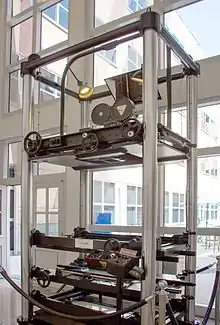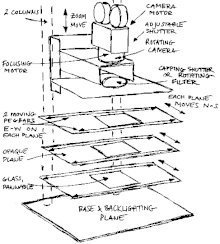Multiplane camera
The multiplane camera is a motion-picture camera that was used in the traditional animation process that moves a number of pieces of artwork past the camera at various speeds and at various distances from one another. This creates a sense of parallax or depth.

Various parts of the artwork layers are left transparent to allow other layers to be seen behind them. The movements are calculated and photographed frame by frame, with the result being an illusion of depth by having several layers of artwork moving at different speeds: the further away from the camera, the slower the speed. The multiplane effect is sometimes referred to as a parallax process.
One variation is to have the background and foreground move in opposite directions. This creates an effect of rotation. An early example is the scene in Walt Disney's Snow White and the Seven Dwarfs where the Evil Queen drinks her potion, and the surroundings appear to spin around her.
History
An early form of the multiplane camera was used by Lotte Reiniger for her animated feature The Adventures of Prince Achmed (1926).[1] Berthold Bartosch, who worked with Reiniger, used a similar setup in his film L'Idee (1932).
While Reiniger used separations on layers of glass to create a separation of elements, there was no parallax illusion creating a third dimensional effect since the camera was at a fixed position. There were no traveling shots moving through space or Pans displaying layers or planes moving in parallax, which is the true definition of what the Multiplane methods accomplished later.
In 1933, former Walt Disney Studios animator/director Ub Iwerks invented the first multiplane camera using movable layers of flat artwork in front of a horizontal camera using parts from an old Chevrolet automobile.[2] His multiplane camera was used in a number of the Iwerks Studio's Willie Whopper and Comicolor cartoons of the mid-1930s.
The technicians at Fleischer Studios created a distantly related device, called the Stereoptical Camera or Setback, in 1934.[3] Their apparatus used three-dimensional miniature sets built to the scale of the animation artwork.[3] The animation cels were placed within the setup so that various objects could pass in front of and behind them, and the entire scene was shot using a horizontal camera.[3] The Tabletop process was used to create distinctive results in Fleischer's Betty Boop, Popeye the Sailor, and Color Classics cartoons.
The most famous multiplane camera was developed by William Garity for the Walt Disney Studios to be used in the production of Snow White and the Seven Dwarfs.[4] The camera was completed in early 1937 and tested in a Silly Symphony called The Old Mill, which won the 1937 Academy Award for Animated Short Film.[5]
Disney's multiplane camera, which used up to seven layers of artwork (painted in oils on glass) shot under a vertical and moveable camera set for successive frame Technicolor,[4] allowed for more sophisticated uses than the Iwerks or Fleischer versions. A camera crew of up to a dozen technicians might be required to operate and advance each of the planes. The senior Disney executive Card Walker rose in the company from the multiplane camera department in the late 1930s. Occasionally the studio used another camera, operating horizontally along tracks laid on a studio floor to allow wider movements (e.g. establishing shot of Pinocchio’s village) or extremely long tracking or complicated dissolve shots (notably the Ave Maria forest sequence). The multiplane was featured prominently in Disney films such as Pinocchio, Fantasia, Bambi, The Adventures of Ichabod and Mr. Toad, Cinderella, Alice in Wonderland, Peter Pan, Sleeping Beauty and The Jungle Book. The camera would be used more rarely in later movies, like The Fox and the Hound, which contains just a single multiplane shot.[6]
The Little Mermaid was the final Disney film to use a multiplane camera, though the work was done by an outside facility as Disney's cameras were not functional at the time.[7] The process was made obsolete by the implementation of a "digital multiplane camera" feature in the digital CAPS process used for subsequent Disney films and in other computer animation systems.[7]
Three original Disney multiplane cameras survive: one at The Walt Disney Studios, Burbank, California, one at the Walt Disney Family Museum in San Francisco, and one in the Art of Disney Animation exhibition at Walt Disney Studios Park in Disneyland Paris.[8]
Impact
Before the multiplane camera, animators found it difficult to create a convincing tracking shot that kept perspective (for instance, a moon of constant size in distant background) by using traditional animation methods. Furthermore, the act of animating the forward motion was becoming increasingly costly and time-consuming. The multiplane camera answered this problem by creating a realistic sense of three dimensional depth in a cartoon setting.
The multiplane also made possible new and versatile types of in-camera special effects for animated films using, for example, 3D practical elements/mock-ups in foreground, filters and planar lighting, distortion glass and reflections, to achieve naturalistic moving water, flickering light and other subtle effects.[9]
See also
References
- "Drawn to be Wild: The life of Lotte Reiniger". bfi.org.uk. 3 March 2001. Archived from the original on 3 March 2001. Retrieved 10 November 2019.
- Pat Williams and Jim Denney (2004). How to Be Like Walt: Capturing the Disney Magic Every Day of Your Life. HCI. p. 133. ISBN 978-0-7573-0231-2.
- Barrier, Michael (2008). DVD audio commentary on King of the Mardi Gras. Bonus Material from Popeye the Sailor: Volume 1 [DVD release]. Warner Home Video.
- "Cinema: Mouse & Man". TIME.com. 27 December 1937. Retrieved 1 July 2020.
- (2001) Audio Commentary by Walt Disney and John Canemaker. Bonus material from Snow White and the Seven Dwarfs: Platinum Edition [DVD]. Walt Disney Home Entertainment.
- Animation: A World History: Volume III: Contemporary Times
- (2006) Audio Commentary by John Musker, Ron Clements, and Alan Menken Bonus material from The Little Mermaid: Platinum Edition [DVD]. Walt Disney Home Entertainment.
- "Art of Disney Animation". DLRP Magic!. Retrieved 16 November 2012.
- "Multiplane Educator Guide" (PDF). Retrieved 19 March 2015.
Further reading
- Telotte, J. P. (2006). "Ub Iwerks' (Multi)Plain Cinema". Animation. SAGE Publications. 1 (1): 9–24. doi:10.1177/1746847706065838. ISSN 1746-8477. OCLC 5723744668.

